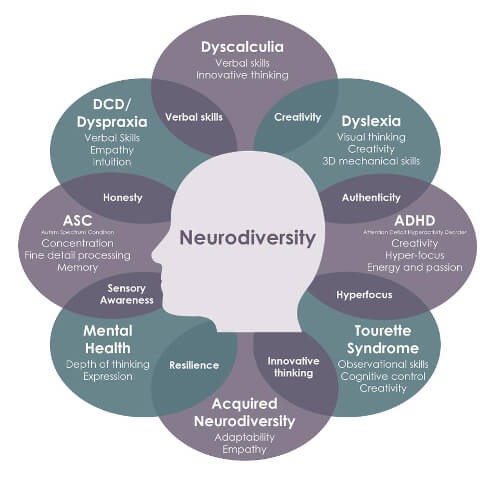Chances are, someone you work with or employ is neurodivergent – possibly without you or even them knowing it.
The term encompasses conditions like autism, dyslexia, and ADHD and represents a significant portion of the UK population, with an estimated 15-20% of people identifying as neurodiverse.
Manifestations of neurodiversity can range from subtle to more pronounced, so it’s not always apparent when someone is neurodivergent.
But here’s the heart of the matter: neurodivergent individuals bring unique perspectives and talents to the table and enrich the workplace tapestry.
Yet, despite growing recognition of these invaluable contributions, the workplace can still pose substantial hurdles for these individuals.
A recent revelation from the Buckland Review of Autism underscores this challenge, highlighting that just 3 in 10 autistic individuals in the UK are in work.
Equally concerning is that almost half of neurodivergent people report having lost or left a job due to being misunderstood, according to the National Autistic Society.
These figures aren’t just statistics; they represent real people with immense potential.
So, how can you transform your workplace into a nurturing environment where neurodivergent employees don’t just survive but flourish?
Neurodiversity: Opportunities and challenges

As we’ve already mentioned, there’s been plenty of insightful research into the many different benefits neurodivergent people bring to the workplace.
The term neurodiverse was first coined by Judy Singer in an undergraduate thesis in 1998. In her paper, Singer asked:
"Why not propose that just as biodiversity is essential to ecosystem stability, so neurodiversity may be essential for cultural diversity?"
Judy Singer
Her work focused on Asperger’s Syndrome, but it coincided with a groundswell of campaigning to raise awareness about neurodiverse conditions and shift the dialogue from one of deficiency to diversity.
When you consider the present demand for out-of-the-box thinking and innovative problem-solving, the benefits of neurodivergent minds speak for themselves.
And it’s not just about thinking differently.
For example, those with ADHD can benefit from hyper-focus, which equips them to thrive in fast-paced, continuously evolving work environments.
When those with autism, ADHD or another neurodiversity feel able to be their authentic selves at work, research suggests a strong correlation with high engagement, passion and loyalty to their work and their workplace.
Scientists have also pointed to strong memory and recall and above-average critical thinking ability amongst neurodivergent individuals.
Few business leaders would argue with the above, but that doesn’t mean their organisation is as neuroinclusive as it could be.
According to a recent CIPD report, 52% of organisations described themselves as having a neuroinclusive culture. Meanwhile, 37% of the neurodivergent employees surveyed felt they were offered meaningful support.
Some of the challenges faced by neurodivergent employees at work today include:
The understanding gap
Neurodivergent people can sometimes struggle to empathise with others, but the same is often true of how people treat their neurodivergent colleagues.
The problem here lies in the gap between awareness and understanding.
While awareness of neurodiversity and how it can manifest itself in people is undoubtedly growing, understanding is still lacking in most cases.
There is still a great deal of misinformation out there around neurodiversity, including viewing it as a behavioural issue rather than what it really is; nervous-system-based.
What’s more, just as no two neurotypical individuals are the same, all neurodivergent people are unique and have their own experiences of their condition.
While you might think you know a great deal about autism, for instance, you may not always recognise it in someone’s actions or behaviour.
This generalist understanding of neurodiversity often translates into ‘one-size-fits-all’ inclusion policies which simply can’t correlate with the broad range of experiences amongst your workforce.
The communication gap
This lack of understanding around neurodivergence can create problems for workplace dynamics.
Autistic people, for instance, often have difficulty recognising or understanding other people’s emotions and expressing their own.
When we rely on neurotypical communication cues, like maintaining constant eye contact when you’re listening to someone, we can easily misinterpret a neurodiverse response as rude or ignorant.
Often, compassion and understanding exist in theory but quickly collapse in the face of challenging behaviours or circumstances.
Autism researcher and academic Beth Radulski wrote a brilliant article on this topic called 'Different Listeners Listen Differently: Crossing the Neurocultural Divide':
"Instead of questioning 'do they look like they're listening?' against a check-list of Neurotypical social cues; ask yourself 'do I feel heard?' by gauging the outcome of the conversation for both parties: Do both parties walk away with a shared understanding? Are mutual goals clarified? Is the take-home message clear to all?"
Beth Radulski
There's no 'one-size-fits-all' approach to listening; it's feeling heard and valued that really creates a sense of inclusion and belonging in the workplace.
The stigma hurdle
Unfortunately, we still have a long way to go when it comes to dismantling stigma around neurodiversity in the workplace. This can impact the way neurodivergent employees are treated, but it also affects their ability to speak up at work.
The aforementioned CIPD report found that 31% of neurodivergent employees have not told their line manager or HR about their neurodivergence.
When asked why, 37% said they were concerned about making assumptions based on stereotypes, and 34% said there was too much stigma around the topic.
Meanwhile, 29% of survey respondents said they were concerned about the possible impact of speaking up on their careers.
The unfortunate result of this is some organisations believing they don’t need to prioritise neuroinclusion because ‘we don’t have much neurodiversity here.’
As we mentioned at the beginning of the article, that’s highly unlikely. Whether you’re dealing with a group of investors, your board or C-Suite, or a set of team members, it’s vital to remember that 1 in 5 people are neurodivergent.
For a long time, neurodiversity has been subject to deficit framing – the idea that neurodivergent people are lacking something – and this view has found its way into the idea that neurodiverse employees can’t succeed in their careers.
This view is being increasingly challenged by neurodiversity activists, who argue that neurodivergent people function just as highly as neurotypical people.
Deficit framing often leads to stereotyping and unconscious bias which excludes neurodivergent employees and can prevent them from progressing within their organisation.
Neurodiversity and mental health
Neurodiversity can sometimes be wrongly labelled as a mental health condition.
While this is incorrect, there is considerable overlap between those with a neurodiverse condition and those with a mental health condition.
According to Austitca, 7 in 10 autistic young people have a mental health condition such as anxiety, depression, or OCD. Meanwhile, 70% of adults with ADHD will have a co-diagnosis of depression.
Because of the difficulties with communication and stigma outlined above, identifying mental health or wellbeing struggles in neurodiverse employees can often go unnoticed.
What’s more, the combined pressures of managing both a neurodiversity condition and a mental health condition in the workplace fuels the high rates of attrition and unemployment amongst neurodivergent people.
How to make your workplace more neuroinclusive
We’ve hopefully made clear both the unique value neurodivergent people bring to the workplace and the numerous obstacles in their path.
So, what can you do to make sure your workplace is as inclusive as it can be?
Guarantee psychological safety
Meeting culture tends to give only the loudest and most confident voices a platform, while neurodiverse individuals often struggle to voice their ideas and opinions within the dictated format.
But when you enable live, anonymous dialogue, you attribute equal weight to every voice and unlock a wider range of perspectives and insights.
Anonymity is the only effective way to dismantle the barriers that prevent neurodivergent voices from being heard at work – including stigma and unconscious bias – and foster true psychological safety.
Consistent and transparent communication
Clarity of message is always important for internal communications, but this is especially true for making sure you reach your neurodivergent community.
As a general rule, steering clear of vagueness, euphemism and sarcasm in company communications helps to prevent misinterpretation.
But it’s not a matter of sanitising all communication to ensure everyone is included – in fact, this risks alienating everyone.
Instead, make all forms of communication clearly visible to all and allow for coregulation – employees helping to make sense of developments together – so that no one is left in the dark.
Facilitate shared understanding
A truly inclusive workplace can’t be engineered from the top down, in the form of company initiatives and a list of shared values.
Peer-to-peer conversation helps your people to better understand the lived experiences and diverse perspectives of their colleagues.
Often, we don’t want to ask about such topics for fear of looking ignorant – but not bothering to find out is far more harmful.
Provide dedicated safe spaces where your people can go to discuss a topic like neurodiversity and learn more about it, ideally with the protection of anonymity.
The collective sensemaking we often see on the Harkn Wall and in our Team Rooms helps to reduce stigma and encourage compassion and understanding.
Proactive wellbeing support
Given that your neurodivergent employees will likely find it harder to raise their hand when they’re struggling than neurotypical employees might, it’s more important than ever to ensure you have proactive wellbeing support mechanisms in place.
Again, anonymity is key to effectiveness here.
Harkn’s wellbeing algorithms detect signs of decline in individuals and process these cases in the Wellbeing Centre, enabling HR and wellbeing professionals to reach out to signpost to further resources without ever revealing that person’s identity.
For those who struggle to speak up at work, early wellbeing support can prevent a crisis from developing.
Be flexible
Your neurodivergent employees or coworkers can transition through multiple states in a short space of time. They might seem calm and contented in a morning meeting, but distressed and overwhelmed a couple of hours later.
Several factors can contribute to this, and they are often things that impact neurotypical people too – sensory overload, stress, tiredness – but feel amplified for neurodivergent people.
Flexible working patterns can help to unlock the full potential of your neurodiverse community.
For example, empowering people to start earlier and finish earlier if it suits them might create the right conditions for them to produce their best work.
Likewise, listening to what your people need from their working environment is crucial. Do they need more quiet time to focus? Less meetings? More 1-1 support? Greater collaboration?
Continuously listening to your people and taking necessary action helps to make work better for everyone.
Let's unlock more neurodiverse voices
Making the workplace more inclusive starts with listening to all of your people. To prevent neurodivergent people from staying on the sidelines of your organisation, you need to empower equal voice.
Organisations can’t underestimate the mitigating impact of factors like power distance, stigma, and fear of consequences on open and honest communication in the workplace.
Over a decade of supporting businesses with their listening strategy has proven to us the importance of anonymity in ensuring psychological safety and fostering a speak-up culture.
You can always learn more about how Harkn can help you deliver on diversity and inclusion in the workplace over a virtual coffee.




